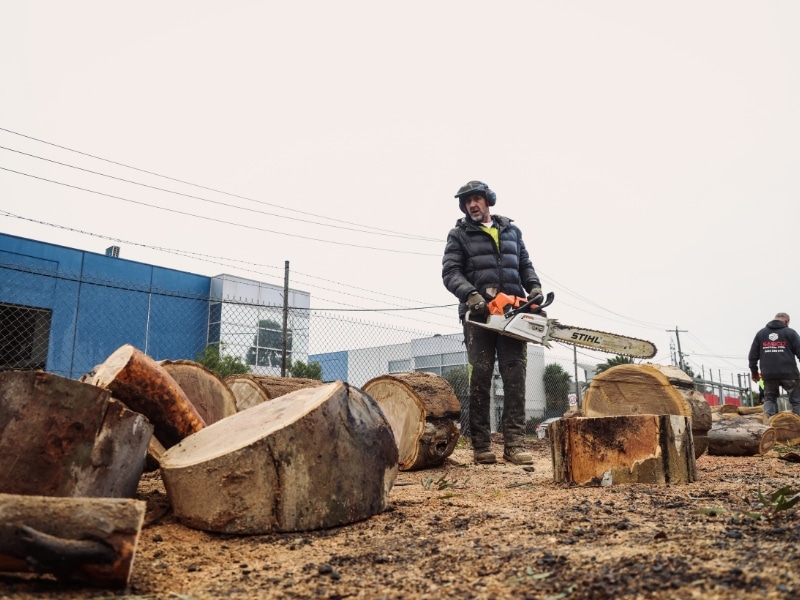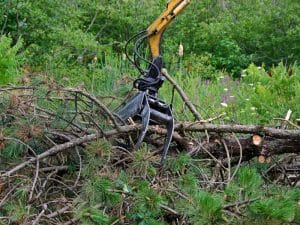Removing a pine tree can seem straightforward, especially if you want to save on costs. However, this simple project can present significant risks to your safety, property, and environment. Tree removal can be a manageable task with the right knowledge and tools. Still, without the proper experience, it can quickly become dangerous. This article will explore the safety risks of removing a pine tree yourself and why it’s often best left to professionals.
How dangerous is it to remove a pine tree without experience?
Removing a pine tree without the proper experience can pose several serious dangers. The risks are not limited to personal injury but include potential damage to your property or the environment.
- Falling branches: Trees or branches can fall unpredictably. You may misjudge weight and direction without proper training, risking injury or property damage.
- Uncontrolled felling: Without experience, directing a tree’s fall is brutal. Improper cuts can cause it to fall in unintended directions, posing serious hazards.
- Chainsaw mishandling: Misusing a chainsaw is a leading cause of injury during tree removal. Training and experience are essential for safe operation.
- Lack of protective equipment: Professionals wear helmets, gloves, and boots. Without this gear, you’re exposed to serious injury.
- Risk of falling: Climbing trees or unstable ladders significantly increases fall risk.
Removing a pine tree without experience can result in injury from falling branches, misjudged felling, chainsaw mishandling, and falls.
What hazards should you consider before removing a pine tree?
Assessing the surrounding environment and potential hazards before removing a pine tree is essential to ensure the process is as safe as possible.
| Hazard | Consideration | Risk Level |
| Proximity to structures | Near buildings, fences, or power lines | High |
| Power lines | Risk of contact during felling | High |
| Unstable ground | Soft or uneven ground | Medium |
| Wildlife | Presence of birds or animals | Medium |
| Weather conditions | Wind, rain, or extreme heat | High |
Before removing a pine tree, consider the importance of proper tree management, including proximity to structures, power lines, unstable ground, wildlife, and weather conditions to ensure safety and avoid accidents.
When should you avoid removing a tree yourself?
While removing a pine tree may be tempting, certain situations indicate that leaving the job to a professional arborist is better. Here are a few scenarios where you should avoid attempting to remove the tree yourself.
- Large tree size: Larger trees are more challenging and dangerous to remove. A towering pine tree requires expert knowledge for safe dismantling.
- Damaged or diseased trees: Severely damaged or diseased trees can be unstable, making removal challenging.
- Location of the tree: For safe removal, professionals should handle trees near high-traffic areas, like roads or structures.
- Lack of experience or tools: Without proper tools or expertise, attempting tree removal can lead to injury or property damage.
- Uncertainty about council regulations: In some areas, removing a tree requires specific permits or approval from local councils. If you’re unsure, hiring a professional who understands these legalities is better.
If the pine tree is large, damaged, or in a tricky location, or if you lack the necessary tools and experience, it’s safer to hire a professional arborist to handle the removal.
Why is tree removal more dangerous than it seems?
At first glance, removing a pine tree might seem like a simple DIY task, but it involves many hidden dangers. Here are a few reasons tree removal is often more dangerous than it looks.
- Tree structure complexity: Trees, especially pine trees, have dense crowns and long branches, making their fall unpredictable.
- Unseen dangers: A damaged, diseased, or unstable root system can cause sudden, unpredictable tree falls.
- Felling techniques: Correct felling ensures the tree falls in the right direction. Without training, misjudging the angle can lead to dangerous outcomes.
- Chainsaw control: Proper chainsaw operation requires skill and focus. Inexperienced users risk making mistakes, potentially causing serious injuries.
- The danger of heights: Climbing a tree to cut branches or remove the trunk exposes climbers to the risk of falling, even for experienced individuals
Tree removal can be more dangerous than it appears due to the complexity of the tree’s structure, hidden hazards, felling techniques, chainsaw control, and the danger of working at heights.
How can weather conditions affect tree removal safety?
Weather conditions play a significant role in the safety of tree removal. Certain conditions can make the task far more dangerous, so they should be considered before attempting to remove a pine tree.
- Wind: High winds make trees unstable, increasing the risk of branches or the entire tree falling unexpectedly.
- Rain: Wet conditions make the ground slippery and unsafe, while wet wood is harder to cut and more prone to splintering.
- Lightning: Lightning often strikes tall trees like pines. If struck, removal may be hazardous due to instability.
- Heat: Extreme heat can cause dehydration, impairing safety and equipment operation.
- Freezing temperatures: Cold weather affects chainsaw functionality, and frozen ground makes tree removal more challenging.
Weather conditions such as wind, rain, lightning, extreme heat, and freezing temperatures can increase tree removal risks, making waiting for better weather or hiring a professional is much safer.
What are the risks of not removing stumps properly?
After removing a pine tree, you may be left with a stump, and levelling the ground after tree removal is essential to prevent several issues caused by improper stump removal. Improper stump removal can lead to several issues.
| Risk | Issue | Impact |
| Trip hazards | Stumps can create hidden tripping risks. | Increases chance of injury |
| Pest infestation | Attracts pests like termites and ants. | Spreads pests to other areas |
| Regrowth | Stumps can sprout new shoots. | Unwanted plant growth |
| Root decay | Decaying roots weaken soil. | Potential structural damage |
| Aesthetics | Leftover stumps are unsightly. | Decreases curb appeal |
Improper stump removal can result in trip hazards, pest infestations, regrowth, root decay, and poor aesthetics. Proper stump grinding is crucial to avoid these issues.
When should you consider hiring an expert to remove a pine tree?
Hiring an expert is essential in many situations, especially when you need to find reliable solutions for pine tree removal. Here’s when you should seriously consider bringing in professionals.
- Large or dangerous trees: Professionals can safely remove large or unstable trees near structures.
- Lack of equipment: Experts have the necessary equipment for efficient tree removal.
- Uncertainty about safety: Hiring an expert ensures the job is done safely and correctly.
- Time constraints: Professionals can complete tree removal quickly, saving you time.
- Legal requirements: An arborist understands local laws and permits for tree removal and can assist with the process.
Suppose you’re dealing with a large, dangerous tree or lack the proper equipment and experience. In that case, hiring a professional arborist is a smart and safe choice.
Conclusion
Removing a pine tree may seem like a simple DIY task but it involves significant safety risks. The process can be dangerous, from falling branches to complex tree felling, weather conditions, and stump removal. If you’re unsure of your abilities or lack the right tools, it’s best to hire a professional arborist for a safe and efficient job.
Thinking about removing that pine tree? See how The Yard handles it with care and expertise.



